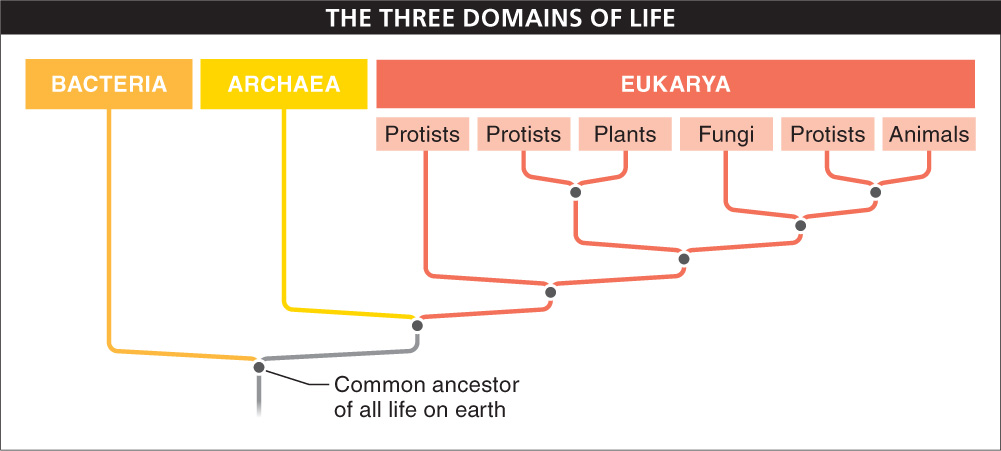
Biological diversity can be humbling. At the very least, it makes it harder to believe that humans are particularly special. We are not at the center of earth’s “family tree.” Nor are we at its peak. We are simply one branch.
When Linnaeus first put together his system of classification, he saw a clear and obvious split: all living organisms were either plant or animal. Plants could not move and could make their own food. Animals could move but could not make their own food. So in Linnaeus’s original classification, all organisms were put in either the animal kingdom or the plant kingdom (his third, “mineral” kingdom, now abandoned, included only non-
With the refinement of microscopes and subsequent discovery of the rich world of microbes—microscopic organisms—
The two-
The classification of organisms took a huge leap forward in the 1970s and 1980s, and the five-
How can one molecule support the claim that all living organisms probably evolved from a single common ancestor?
Woese assumed that the more similar the genetic sequences were between two species, the more closely related they were, and he built phylogenetic trees accordingly. The only way Woese could compare the evolutionary relatedness of all the organisms present on earth today was by examining one molecule that was found in all living organisms and looking at the degree to which it differed from species to species. He discovered a perfect candidate for this role: a molecule called ribosomal RNA, which helps translate genes into proteins (see Chapter 5). Ribosomal RNA has the same function in all organisms on earth, almost certainly because it comes from a common ancestor. Over time, however, its genetic sequence (i.e., the DNA that codes for it) has changed a bit. Tracking these changes makes it possible to reconstruct the process of diversification and change that has taken place.
433
The trees that Woese’s genetic sequence data generated had some big surprises. First and foremost, the sequences revealed that the biggest division in the diversity of life on earth was not between plants and animals. It wasn’t even between prokaryotes and eukaryotes. The new trees revealed instead that the diversity among microbes was much, much greater than ever imagined—

Woese put the domains above the kingdom level in the Linnaean system. In Woese’s new system, which is the most widely accepted classification scheme today, the bacteria and archaea domains each have one kingdom and the eukarya domain has four. Because both bacteria and archaea are microscopic, it can be hard to believe that the two domains are as different from each other as either domain is from the eukarya. However, each of the three domains is monophyletic, meaning that each contains species that share a common ancestor and includes all descendants of that ancestor. Close inspection even reveals that the archaea are more closely related to the eukarya than they are to the bacteria.
The three-
Are viruses alive?
Additionally, a fourth group of incredibly diverse and important biological entities, the viruses, is not even included in the tree of life, because they are not considered to be living organisms. Viruses can replicate, but they can have metabolic activity only by taking over the metabolic processes of another organism. Their lack of metabolic activity puts viruses just outside the definition of life that we use in this book, but some scientists do view viruses as living.
The most commonly accepted tree of life suggests that, after the origin of life, the following sequence of events occurred (FIGURE 10-28):
- 1. The bacteria arose from the first self-
replicating, metabolizing cells. - 2. There was a split between the bacteria and a line that gave rise to the archaea and eukarya.
- 3. The fusion of a bacterium and an archaeon-
like prokaryote gave rise to the eukarya, which then split from the archaea line.

434
The next three sections introduce each of the three domains, surveying the broad diversity that has evolved within each domain and the common features that link all the members of each. Chapters 11, 12, and 13 cover the domains in greater detail.
TAKE-HOME MESSAGE 10.15
All life on earth can be divided into three domains—
Is the three-
The current three-domain, six-kingdom approach is still subject to revision. The challenges inherent in classifying cryptic, poorly studied, microscopic, or extinct organisms continue to challenge taxonomists.